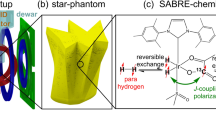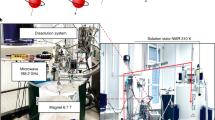Abstract
As currently implemented, magnetic resonance imaging (MRI) relies on the protons of water molecules in tissue to provide the NMR signal. Protons are, however, notoriously difficult to image in some biological environments of interest, notably the lungs1 and lipid bilayer membranes such as those in the brain2. Here we show that 129Xe gas can be used for high-resolution MRI when the nuclear-spin polarization of the atoms is increased by laser optical pumping and spin exchange3–6. This process produces hyperpolarized 129Xe, in which the magnetization is enhanced by a factor of about 105. By introducing hyperpolarized 129Xe into mouse lungs we have obtained images of the lung gas space with a speed and a resolution better than those available from proton MRI1,7 or emission tomography8,9. As xenon (a safe general anaesthetic) is rapidly and safely trans-ferred from the lungs to blood and thence to other tissues8,9, where it is concentrated in lipid10–15 and protein13,15–18 components, images of the circulatory system, the brain and other vital organs can also be obtained. Because the magnetic behaviour of 129Xe is very sensi-tive to its environment, and is different from that of 1H2O, MRI using hyperpolarized 129Xe should involve distinct and sensitive mechanisms for tissue contrast.
This is a preview of subscription content, access via your institution
Access options
Subscribe to this journal
Receive 51 print issues and online access
$199.00 per year
only $3.90 per issue
Buy this article
- Purchase on Springer Link
- Instant access to full article PDF
Prices may be subject to local taxes which are calculated during checkout
Similar content being viewed by others
References
Bergin, C. J., Pauly, J. M. & Macovski, A. Radiology 179, 777–781 (1991).
Bárány, M. et al. Magn. Reson. Imaging 5, 393–398 (1987).
Bhaskar, N. D., Happer, W. & McClelland, T. Phys. Rev. Lett. 49, 25–28 (1982).
Happer, W. et al. Phys. Rev. A29, 3092–3110 (1984).
Cates, G. D. et al. Phys. Rev. A45, 4631–4639 (1992).
Raftery, D. et al. Phys. Rev. Lett. 66, 584–587 (1991).
Gewalt, S. L. et al. Magn. Reson. Med. 29, 99–106 (1993).
Susskind, H. et al. Prog. nucl. Med. 5, 144–170 (1978).
Susskind, H., Ellis, K. J., Atkins, H. L., Cohn, S. H. & Richards, P. Prog. nucl. Med. 5, 13–34 (1978).
Pollack, G. L., Himm, J. F. & Enyeart, J. J. J. chem. Phys. 81, 3239–3246 (1984).
Wilcock, R. J., Battino, R., Danforth, W. F. & Wilhelm, E. J. chem. Thermodynam. 10, 817–822 (1978).
Wilhelm, E., Battino, R. & Wilcock, R. J. Chem. Rev. 77, 219–243 (1977).
Wishnia, A. Biochemistry 8, 5064–5070 (1969).
Miller, K. W. et al. Proc. natn. Acad. Sci. U.S.A. 78, 4946–4949 (1981).
Albert, M. S., Springer, C. S., Murphy, R. & Wishnia, A. Abstr. 11th A. Mtg Soc. magn. Reson. Med. (ed. Wehrli, F. W.) 2104 (SMRM, Berkeley, California, 1992).
Wishnia, A. Biochemistry 8, 5070–5075 (1969).
Schoenborn B. P. J. molec. Biol. 45, 297–303 (1969).
Tilton, R. F. Jr & Kuntz, I. D. Jr Biochemistry 21, 6850–6857 (1982).
Jameson, C. J., Jameson, A. K. & Hwang, J. K. J. chem. Phys. 89, 4074–4081 (1988).
Diehl, P. & Jokisaari, J. J. mag. Reson. 88, 660–665 (1990).
Albert, M. S., Springer, C. S. & Wishnia, A. Abstr. 11th A. Mtg Soc. magn. Reson. Med. (ed. Wehrli, F. W.) 4710 (SMRM, Berkeley, California, 1992).
Blumgart, H. L. & Weiss, S. J. clin. Invest. 4, 339–411, 423–425 (1927).
Knudsen, G. M., Pettigrew, K. D., Patlak, C. S. & Paulson, O. B. Am. J. Physiol. (in the press).
Fullerton, G. D. & Cameron, I. L. in Biomedical Magnetic Resonance Imaging (eds Wehrli, F. W., Shaw, D. & Kneeland, J. B.) 147 (VCH, New York, 1988).
Ogawa, S. et al. Proc. natn. Acad. Sci. U.S.A. 89, 5951–5955 (1992).
Mayo, J. R. et al. Radiology 163, 507–510 (1987).
Newbury, N. R., Barton, A. S., Cates, G. D., Happer, W. & Middleton, H. Phys. Rev. A48, 4411–4420 (1993).
Cates, G. D. et al. Phys. Rev. Lett. 65, 2591–2594 (1990).
Gatzke, M. et al. Phys. Rev. Lett. 70, 690–693 (1993).
Haase, A., Frahm, J., Matthaei, D., Haenicke, W. & Merboldt, K. D. J. mag. Reson. 67, 258–266 (1986).
Albert, M. S., Huang, W., Lee, J.-H., Patlak, C. S. & Springer, C. S. Jr Magn. Reson. Med. 29, 700–714 (1993).
Author information
Authors and Affiliations
Rights and permissions
About this article
Cite this article
Albert, M., Cates, G., Driehuys, B. et al. Biological magnetic resonance imaging using laser-polarized 129Xe. Nature 370, 199–201 (1994). https://doi.org/10.1038/370199a0
Received:
Accepted:
Issue Date:
DOI: https://doi.org/10.1038/370199a0
This article is cited by
-
Review of noble-gas spin amplification via the spin-exchange collisions
Science China Information Sciences (2022)
-
Application of a stretched-exponential model for morphometric analysis of accelerated diffusion-weighted 129Xe MRI of the rat lung
Magnetic Resonance Materials in Physics, Biology and Medicine (2021)
-
Xenon binding by a tight yet adaptive chiral soft capsule
Nature Communications (2020)
Comments
By submitting a comment you agree to abide by our Terms and Community Guidelines. If you find something abusive or that does not comply with our terms or guidelines please flag it as inappropriate.



